Blues are giving me complexes. Or are my complexes giving me the Blues?
By Steve Cary
Please allow me a moment to honor and remember the life of Linda Wiener Elmore, who recently and far too soon metamorphosed to the mysterious afterlife. There has been no greater bug lover than Linda, and that included butterflies, a passion we shared. Linda was one of my favorite New Mexico butterfly collaborators. It was she who undertook and carried out Santa Fe’s first butterfly counts. She was a keen observer in both senses of the word: sharp-eyed and enthusiastic. Linda had a way of looking at nature that helped others see the complexities from new angles, then she often threw in her hearty laugh as punctuation. I particularly remember two of her projects. Once she undertook to count the number of different spiders that shared her Santa Fe residential lot. Over a multi-year effort she found an eye-opening ~200 different spider species. Then consider the humble juniper tree . . . Linda spent the time and patiently invested the brain power to demonstrate that ~400 different invertebrate forms were occupying that tree-space, where I saw only Juniper Hairstreaks. Her educational skills were epic and she enjoyed sharing them professionally and avocationally. When I was a naturalist at the Randall Davey Audubon Center, she was happy to come to the property and deliver stimulating programs for the public. Linda brought her provocative blend of intellectual fizz and infectious laughter to whatever she did. That luminous bubble of energy was an unforgettable presence and all in her world were enriched by it. Happy trails, Linda, we will miss you.
For a while now, I’ve been envisioning a thread that confronts some of the more significant identification challenges for New Mexico butterflyers. One reader suggested that topic. Other correspondents regularly present photos wondering if the subject is species A or species B, and it can be a tough call. I think each of us has her/his own personal ID challenges that arise when two (or more) species look alike. Those ID challenges also seem to have a psychological component, nothing to do with the creatures themselves, but with the very understandable human desire to know what that insect is. For me to feel in control of my surroundings I need to make a species-level identification, to put a name on that picture file, to have a box into which I can place all of my experiences with that bug. (Geez, that quickly deteriorated from humans in general to me in particular . . . oh well, I’m no psychologist!)
I continue to struggle with Acmon and Lupine blues, whose different identities and diagnostic elements have long been a bugaboo for me. I have deftly dodged the issue for decades, but ongoing work by some professional colleagues looks like it may force me to face the music . . . eventually. Until that day of reckoning, however, this devilish duo continues to stalk me. Am I exaggerating? Please read on and you decide.
Recently at Eagle Nest Lake State Park I photographed a blue that was hanging around Redroot Buckwheat (Eriogonum racemosum). It behaved as if it were Spalding’s Blue, but it lacked the band of orange spots on the ventral forewing and so could not be. After considering the alternatives, I tentatively concluded it was my nemesis: Acmon/Lupine Blue. I took plenty of photos (they don’t cost anything) of male and female, dorsal and ventral, hoping that with some study I could finally learn the key characteristics and figure one of these species out on my own.
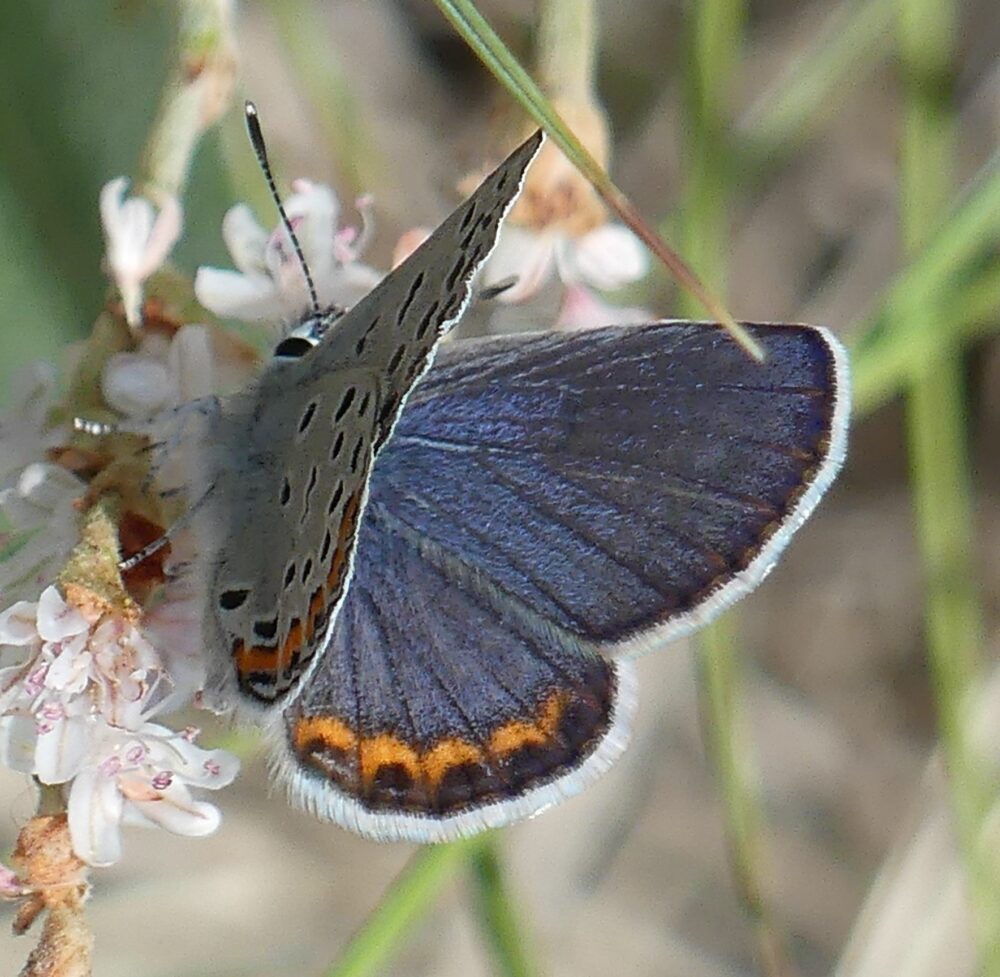
I studied my photos and researched my books, developed my opinion and then asked two accomplished, highly respected experts from Colorado, two fellows I am fortunate to call friends: Mike Fisher (author of Butterflies of Colorado) and Dr. Paul Opler (Assistant Director of the C. P. Gillette Museum of Arthropod Diversity at Colorado State University). My esteemed colleagues very kindly examined my photos and within a couple of days I had their thoughtful, well-reasoned, completely rational conclusions . . . which were totally opposite to each other. Mike was persuaded by the association with buckwheat that this was a Lupine Blue. (I know, why is a Lupine Blue hanging out on a buckwheat? Don’t get me started. It’s a longer story, which I intend to eventually tell on these pages.) Dr. Opler weighed in on the other side, explaining why he thought all the info was consistent with Acmon Blue. I sent each the note from the other, and each graciously conceded the other could be right.
Heartburn was not exactly the feeling I experienced. It was more like bemused hopelessness. I simply had to laugh! If they thought it could be either, what chance did I have of figuring it out? Dr. Opler did say something very sobering, however. He said it did not really matter what anyone thought they were because they were merely photographs. The implication was that people could debate the identity of images until the cows came home, but what truly mattered was the identity of the insects themselves, and that would only be revealed through more detailed scientific examination of specimens: genitalic dissection, DNA analysis to name a couple of routes to follow. And in fact, that work is being undertaken. Once the critters are successfully diagnosed, an effort must be made to pinpoint characters that can be observed in the field (or on photos) and used to distinguish one from the other. You go, Paul! Now I need to be patient, not something that comes naturally to me.
Considering all that’s going on in our world, what’s my best move? Well, obviously, I went to chase butterflies in the Zuni Mountains of Cibola County. The US Drought Monitor suggested that area was not as dry as locations more local to me and it’s a straight shot, 1 full gas tank, 2.5-hour drive from my house: out the door by 6:00 AM, feet on the ground by 8:30, home by 5:00 PM. No contact with potential super spreaders. Plus there are good canyons, good mudholes, a good hilltop, and good butterflies.
On that recent outing the first Blue I saw was “Spring” Azure (Celastrina ladon). They were fresh and numerous, which was a little surprising considering it was July 8. Southern New Mexico has two to three broods of azures each year. Northern New mexico typically has one, in the spring, but maybe our lengthening growing season will enable a second generation in some years.
Of late, some of you are calling these butterflies Echo Azures (Celastrina echo), but I have not given up on Spring Azure just yet. This and other localized Azure taxa, sometimes with specialized hostplants, have been described from various parts of the US. I consider their taxonomic status to be up for discussion. “Echo Azure” is part of a complex of Azures that bedevil taxonomists, so this name and arrangement are best considered tentative. Our New Mexico populations are assigned to subspecies cinerea (W. H. Edwards), but is it a subspecies of Celastrina echo or Celastrina ladon (Cramer)? or even of the more traditional Celastrina argiolus (Linnaeus)?
Which Azure did I see in the Zunis? I won’t pretend to know, but I’m calling it ‘Spring Azure complex’ as suggested by Brock and Kaufman (2003). Spring Azure is a “complex” of organisms, whether species, subspecies, or forms, and no one really knows which is what. Experts have staked out hypotheses and educated opinions which will stimulate continued investigation that will lead us inexorably to the truth, within my lifetime, one hopes, though perhaps not. Until then, “Spring Azure complex” is a properly descriptive container for these beautiful creatures.
On to other Blues, for which evaporating mudholes are magnets on summer days because precious salts accumulate along their drying perimeters. Next in view was another expected species: Western Tailed-blue. A quick preview of my photos, however, did not look quite right. It had patches of orange in places that made me think it was an Eastern Tailed-blue, which I did not expect. Richard Holland’s report on his multi-year butterfly survey in the Zuni Mountains during the 1970s listed Western Tailed-blue, but not its Eastern cousin.* As a very careful collector and observer who was born and raised back East, he undoubtedly knew the difference.
Both species occur in southwest New Mexico, but were they both in the Zunis, too? Easterns usually have more orange in the hindwing false head, especially on the underside, whereas the orange is much more limited on the Westerns. There were quite a few tailed blues sipping contentedly at a local salt lick along Forest Road 504, so I took a bunch of photos hoping to get enough evidence to be able to figure out what was there (does that sound familiar?). One individual of unknown gender, below, displayed more ventral orange than any tailed-blue I’ve ever seen, even up onto the forewing margin. Compare it to the subsequent photo of Western Tailed-blue taken in the Zunis back in May 2008, for which orange on the ventral hindwing is limited to two cells near the tail.

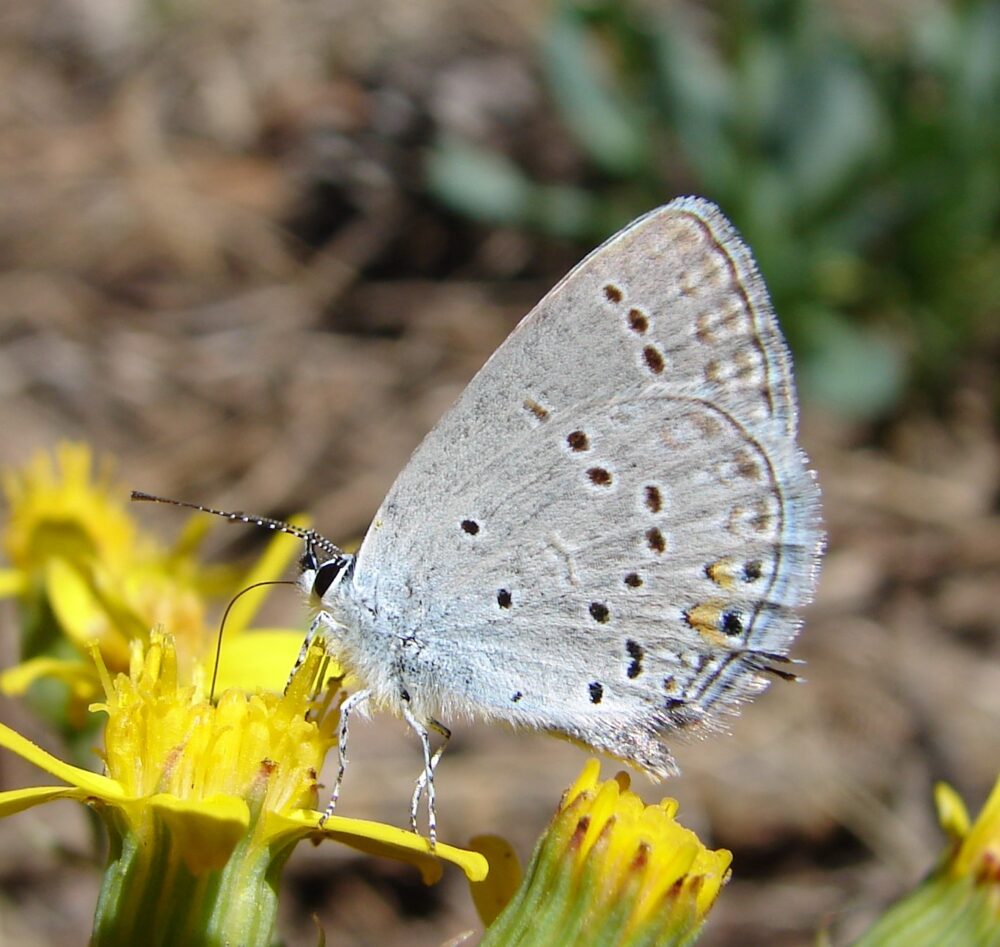
If we examine upperside characters, consider the two images that follow. The first, taken in the same area in the Zunis on May 4, 2020, shows a male with distinct smudges of orange in two cells near the tail. This is consistent with Eastern Tailed-blue. For comparison I offer the second photo below showing a standard male Western Tailed-blue dorsum with no orange whatsoever. For the sake of time, but with some misgivings, I’ll pass over the same analysis for females . . .
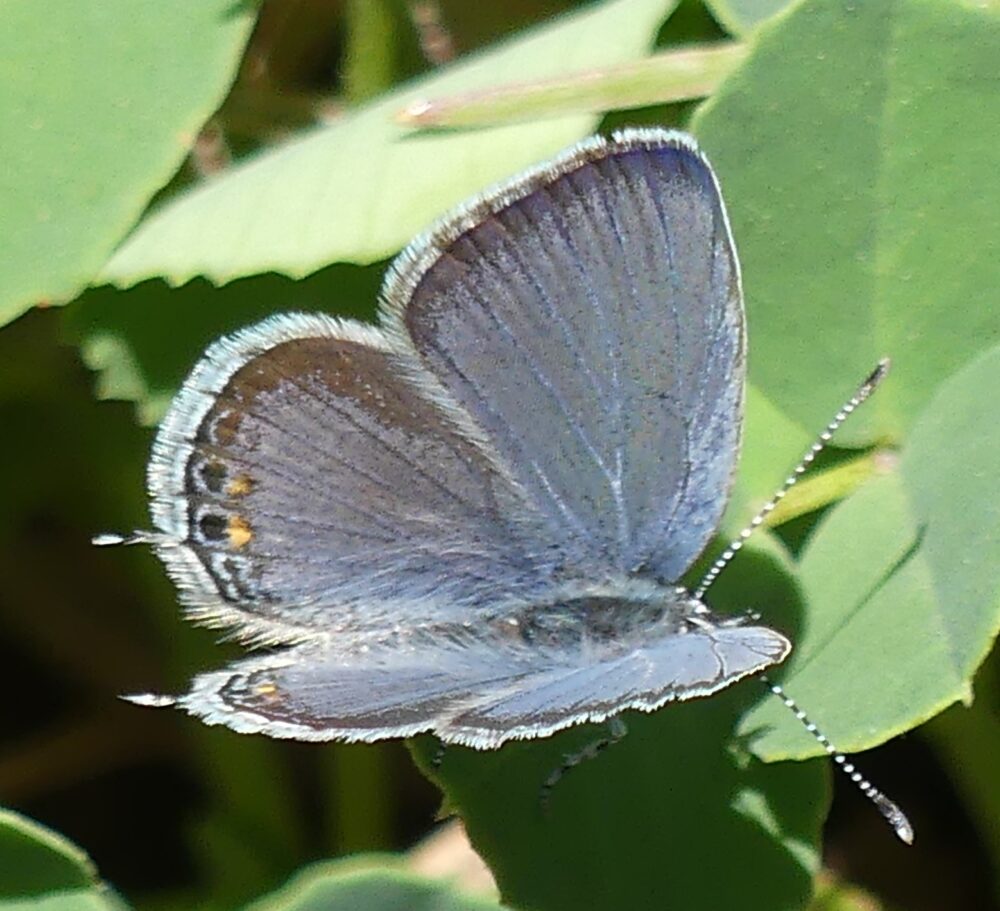

Dorsal and ventral images collectively support the idea that Eastern Tailed-blues are present in the Zunis, at least this year, if not before. This was not something I expected. When venturing into New Mexico’s bigger mountains I always expect to find Western Tailed-blues, not Easterns, and this is based on decades of experience.
Are Western Tailed-blues still in the Zunis? Brock and Kaufman (2003) explained that where these two species overlap in the West, Easterns tend to occupy lower habitats and Westerns inhabit higher sites. That has held true in New Mexico. The Zunis are not particularly high, topping out at a mere 9,200 feet. Places where I found Easterns this year were in the higher portions of Zunis, from 7,800 to 8,800 feet elevation on the slopes of Mt. Sedgwick, the highest peak in the range. There were no higher habitats in which to search for Western tailed-blues. If Westerns were there, I think I would have come across at least one. Perhaps our warming climate is allowing Easterns to penetrate the Zunis, while making life difficult there for Westerns.
The closest thing I’ve seen to a Western tailed-blue, so far is shown in the photo below. This male looks at first glance to have no orange on the hindwing, a la Western, but if you look closely (maybe tilt your computer at the right angle?) you can see a small glint of pink/orange in the cell near the tail. Is this a Western Tailed-blue or a lightly marked Eastern?
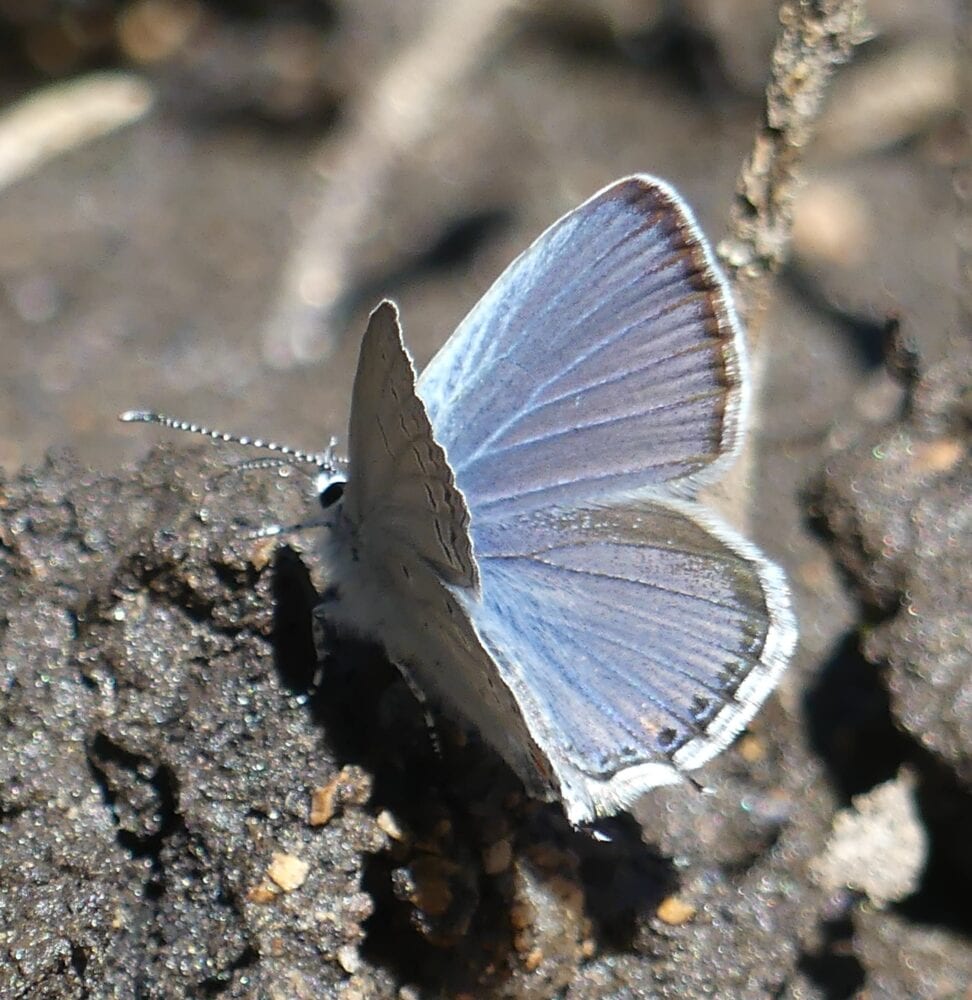
Brock and Kaufman (2003, p. 124) said that male Easterns usually show one or two orange spots near the tail while Westerns usually lack orange near the tail, implying there are exceptions. Does this male show enough orange to call it an Eastern? Glassberg (2017) put it right out there and stated that it is unknown how to separate these two blues “with certainty.” One then wonders, where they co-occur, can the two tailed-blue species identify each other with certainty when it comes to breeding? Is it hybridization that produces the intermediate amount of orange? More study clearly is needed. Documentation of what you see can be important, especially regarding tailed blues in the Zuni Mountains. Perhaps they will join the fun and become their own complex! A second brood of tailed blues can be expected in August.
After Spring Azure and Eastern Tailed-blue, the last Blue species I encountered while butterflying in the Zunis last week was, yes, you guessed it — that squishy Acmon/Lupine thing again. That complex does occur statewide, so clearly it is tag-teaming me. Hey, just because one is paranoid does not eliminate the possibility that one is being harassed.
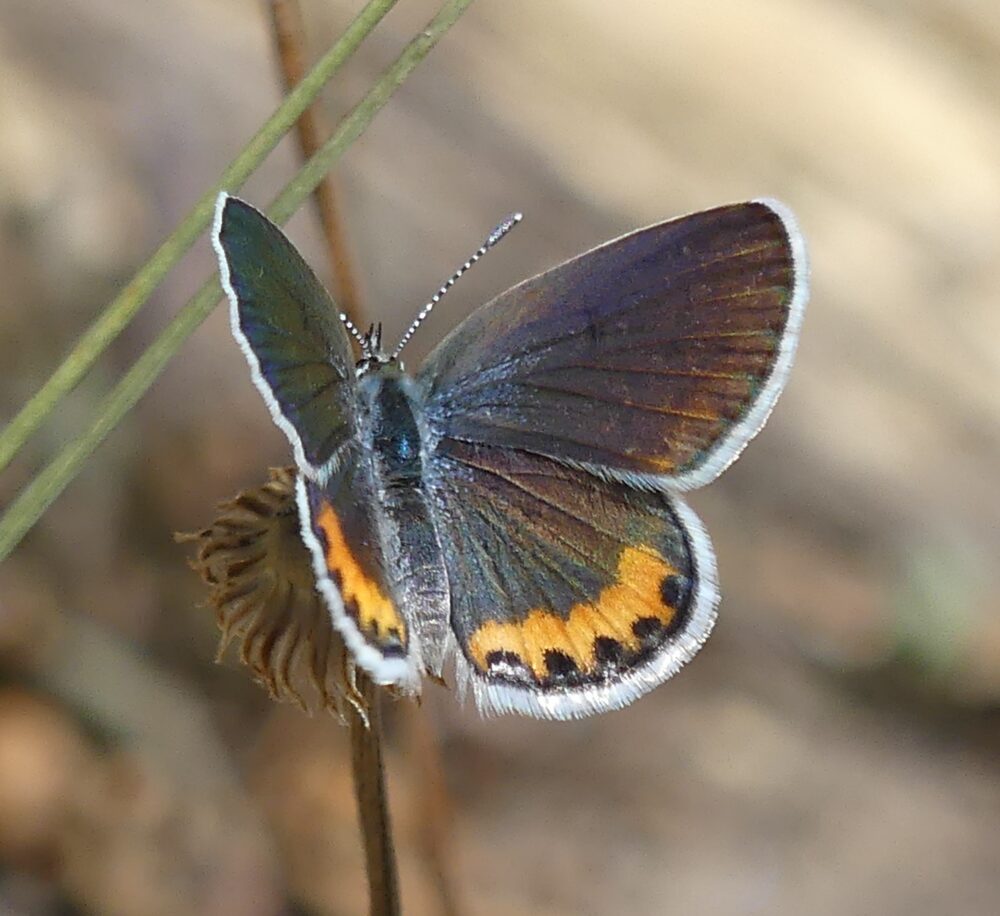
For the time being, the only way I can manage the anxiety is to call Acmon/Lupine Blues a complex. What better word to describe our ignorance or perhaps the reality of life on the ground? Our taxonomic framework of well-defined boxes might work for my brain, or your brain. It may even be accurate in many situations, but there must be circumstances in which two organisms are incompletely separated, whether geographically, temporally, or reproductively. For most of us butterfly watchers, gardeners, and photographers, our knowledge of some butterflies will never attain that degree of specificity. In those cases, I suggest we embrace the complex. Why not accept it as an opportunity, even a privilege, stemming as it does from the majestic, inscrutable, perhaps never fully knowable, Nature?
August is on the horizon (where did summer go?). If you can be safe doing so, in-state, I invite you to seek out Wild Buckwheats and their inscrutable herbivores! Go get your own Dotted Blues! And do your rain dance.
- Holland, Richard. 1984. Butterflies of Two Northwest New Mexico Mountains. Jour. of the Lepid. Soc. 38(3):220-234.

I was much happier when I didn’t realize that seeing a Lupine Blue in NM was a possibility.
I’d love to see any of these. Will stalk the buckwheats Saturday for sure
Will certainly check out the buckwheats in the eastern slopes of the Black Range !